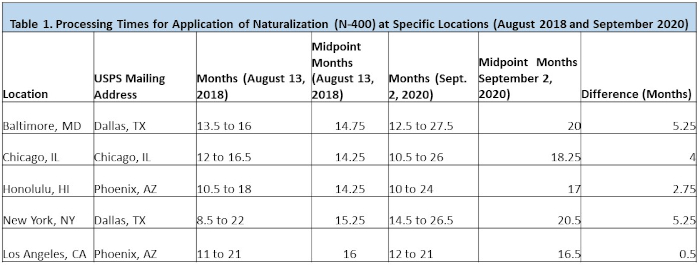
Processing times for many applications are exceedingly long at U.S. Citizenship and Immigration Services (USCIS), and there needs to be a way to shorten them. Almost two years ago I reported that processing times were long. They have even gotten worse in some cases, but it appears that USCIS is making an attempt to be more transparent. With the added transparency, however, USCIS should become more accountable to the customers.
USCIS maintains a processing times website. Processing times are related to the forms for citizenship, residency, and various kinds of authorization to live and work in the United States. The table below shows processing times for the N-400 Application for Naturalization, at five different locations for August 13, 2018 and for September 2, 2020, just over two years later.
For every city (in 2020 versus 2018), the midpoint processing time was a half-month longer in Los Angeles to more than five months longer in Baltimore, MD. USCIS does not provide any explanation as to why the processing times in 2020 are longer than the processing times in 2018. However, some of the added time could be explained by the impact that Covid-19 is having on the U.S. economy.
More recently, USCIS published on their website a table entitled: “Historical National Average Processing Time (in Months) for All USCIS Offices for Select Forms By Fiscal Year Fiscal Year 2016 to 2020 (up to June 30, 2020).” For the N-400, shown in Table 2 below, the average processing time for FY 2020 was 8.3 months. Over the past five years, the longest it took was 10.3 months on average in 2018. But for the five cities shown in Table 1, it took between 16.5 and 20.5 months for people to have their applications processed.
Comparing the processing time data for the five cities identified in Table 1 and similar data for the United States as a whole suggests that at least for the N-400, individuals needing access to how long it will take to process their application should not rely on the national data because it is not relevant to their situation.
For this reason, some people may criticize them for publishing incorrect data. More specifically, some individuals might complain that the general data for the nation as a whole does not apply to their specific case.
In summation, USCIS has made some positive steps by publishing national data for the previous years on their website. But they could do better by publishing historical data by city and by type of application. That way, applicants would have a clearer understanding of how long it would take for their application to be processed. Moreover, USCIS could celebrate improvements in the processing times and identify remedies when processing times worsen.





